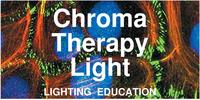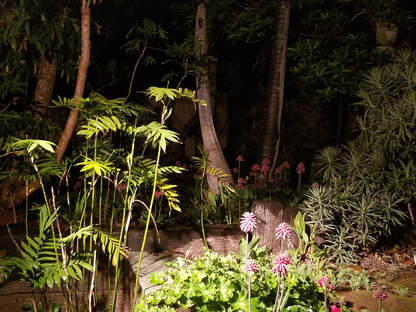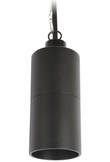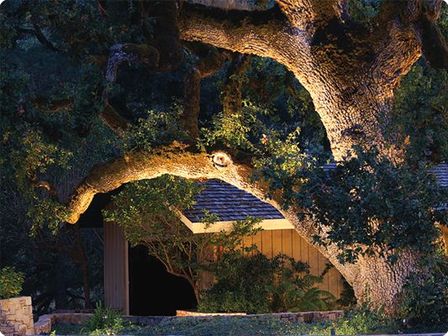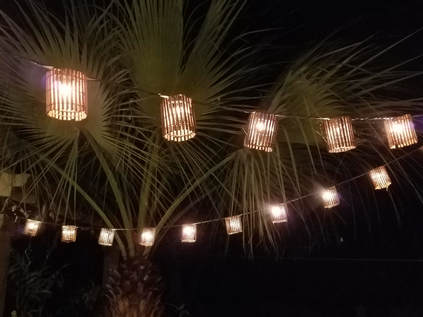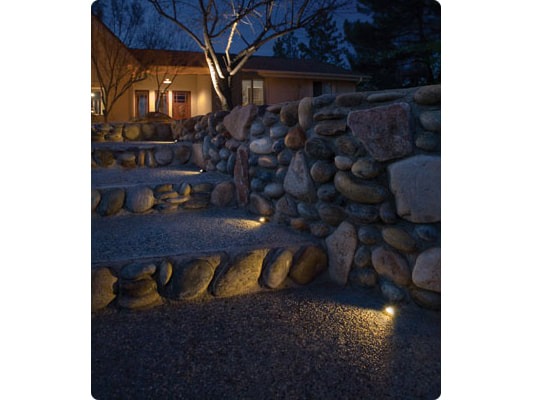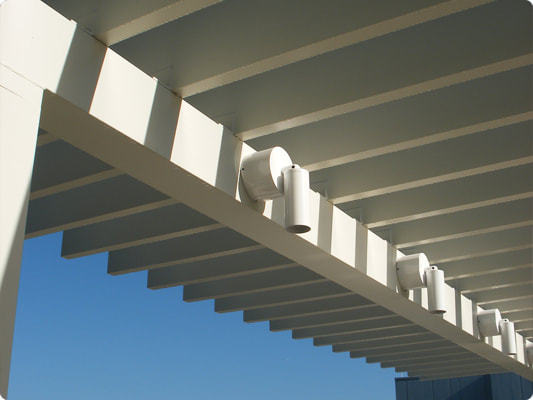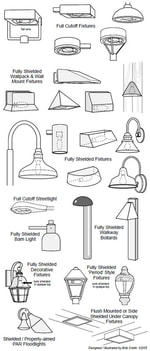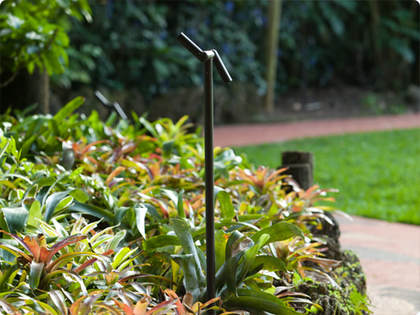Landscape Lighting - Illuminating gardens at night, good neighbor lighting, light trespass, night lighting levels and color temperature.
Learning Objectives - Landscape Lighting
Tips for Landscape Lighting
Outdoor lighting, any lighting, benefits from understanding theatrical lighting. Having a single dim light behind a window creates mystery on stage, what will happen next? Sometimes on stage, and often outdoors, a little light goes a long way.
Pick a few plants to light near, back, and far. This will create depth, just like using low, middle, and tall plants in your perennial border. With light you create a visual destination in the background that will show the depth and scale of the garden. Keep it subtle, you want to make a suggestion of light rather than a focus. It takes up to 20 minutes for your eyes to adjust to dim lighting, if it is too bright, you will never see the non-illuminated parts of the garden. If it is dim, as your eyes adjust, the tree you feature in the background will be revealed. It is easy to overdo it with outdoor lighting. As in interiors, you want ‘layers of light’ with opportunities to have different combinations of lights on and off.
Grey foliage and white flowers are easiest to light at night. Look at what shows up in your garden under the full moon, Red flowers disappear, while white ones glow nicely. Moon LightingShine lights down whenever possible. ‘Moonlights’ are designed to hang from tree branches and simulate the moon light falling onto the path or plants below. Try to avoid the ones with tiny holes drilled into the sides, since they create ‘daggers of light’ that can be blinding. Plus the glowing holes give away the secret light locations, dampening the mystery of hidden lighting.
Lighting Trees
Uplighting into tree branches is tricky. You need a canopy of leaves or branches and tree trunk to catch the light and reflect it back, since we cannot see the light until it strikes a surface and bounces back to your eye. Sometimes leaves will be translucent and glow softly for a nice effect, experiment with a flashlight to predict your results.
Trunks and branches can be illuminated with spotlights from the ground; however, this creates wasted light shining into the sky and prevents stargazing. Carefully select which trees and where to put your lights. Deciduous trees and large trees have interesting branches and bark. To show off the texture of the bark, you want ‘grazing’ light, that hits the bark at a sharp angle to create shadows and highlight the texture. If you are lighting from the ground, place fixtures so that the light grazes the branches. For a huge specimen you can use three floodlights from the ground, for giant oaks at a wedding venue I have used five. This is where your theatrical lighting comes in. You want variety of angles and beam spreads, spot for intense focus and brilliance on one side of the trunk (key light), medium beam for balance coming from the other side to show the trunk or branch is round (fill light), and wide beam or flood from behind into the canopy for depth and background (back light). Outdoor DiningMany people like twinkle lights for outdoor dining.
Lighting Steps & Stairs
When lighting steps and stairs the goal is to alert guests to changes in height, direction, and texture. These changes are surprises that in the dark become tripping hazards.
A rule of thumb for stairs is to light the top, bottom, and in between on long runs. Color Temperature of Landscape Lights
Low Voltage Wiring
Most outdoor landscape lighting is ‘low voltage’ meaning the standard 120 volt power has been modified to 12 or 24 volts. You can ask your electrician leave ‘long leads’ of coiled extra wire, so you can move and adjust the lights before the final installation is finished.
You will probably have a ‘transformer’ installed in a shed, garage, side of a building, or underground weatherproof box, to convert the 120 volt to 12 volt before it is distributed into the garden. Today, some companies, have individually addressable fixtures, so that you can dim, turn on or off, and adjust the color of each fixture separately, even though they are on the same power supply. This type of system is useful in large public gardens; however, may be too pricey and unnecessary for a residence. |
Good Neighbor LightingBe thoughtful to neighbors, by only having the lights on when you are viewing or entertaining. Consider light trespass and direct glare (seeing the bulb) from your neighbors point of view. Shield all light sources from view for your own and neighbor's visual comfort. Preserve the dark sky - at night, put light where it is needed, keep it warm, keep it dim. Light Pollution, Light Trespass, Night Lighting Levels and Color Temperature, Sources, Astronomy, Dark Sky, Circadian System
What is Light Pollution?
The inappropriate or excessive use of artificial light – known as light pollution – can have serious environmental consequences for humans, wildlife, and our climate. Components of light pollution include:
Local Outdoor Lighting Ordinances
Many cities and counties have an outdoor lighting ordinance restricting lighting levels, duration, and color temperature. Check with your jurisdiction about regulations before investing in your outdoor landscape lighting system. See Dark Sky & Ordinances page.
Dark Sky Lighting Fixtures
Outdoor Lighting Manufacturers & Materials
There are many outdoor lighting manufacturers, if you want your equipment to last 20 years, many good companies make high quality equipment, look at warranty details, five years is a good warranty, although they should last much longer. If you are experimenting and are happy with 2 or 10 years, go with a less expensive brand.
Finish - the finish is one of the biggest challenges with outdoor lighting equipment, near the ocean even more difficult. Rust is a type of patina that forms the familiar red orange gritty surface on steel, eventually rusting through reducing the strength, other metals will patina by chalking or changing color.
Solar Powered LED Path Lights
Footnotes
Photo Credits
Unless noted, all photos on this page courtesy of BK Lighting
Related Topics
|
- Home
-
- CHROMA Topics
- Color Spectrum - Light is Energy
- Color in Light
- Color in Nature
- Color in Paint
- Why does paint fade?
- Color Names & Meanings
- Color Phenomena
- Color Perception is Individual
- Color In Fashion
- Color for your home
- Color in Space
- Color Blindness
- Color Blind Interview
- Synesthesia
- Synesthete Deborah Borrowdale-Cox
- Synesthete Stephen Orr, BH&G Editor
-
- Circadian & THERAPY Topics
- Circadian Explained
- Circadian Ganglion Cells
- Circadian Melatonin
- Circadian Animals
- Circadian Research
- Autism & Lighting for the Spectrum
- Blue Light Dimming Apps
- Red Night Lights
- Vitamin D & Light
- SAD - Seasonal Affective Disorder
- Alzheimers and Light Therapy
- Photosensitivity - Light Sensitive Drugs
- Red Light Therapy
- Sleep & Lighting
- Dreams and Second Sleep
- NASA - Lighting in Space & Undersea
- Jet Lag
- Sunglasses
- Chakras
- Crystals, Minerals, & Gemstones
-
- LIGHTing Design Topics
- UV Germicidal Disinfection Light
- LED Lighting Facts Card
- CRI - Color Rendering Index
- LED TM-30
- LED Kelvin Color
- LED LPW
- LED Flicker
- LED Glare
- OLED - Organic LED
- Human Centric Lighting
- Lighting with Daylighting
- Lighting for Healthy Buildings & Zero Net Energy
- Lighting for Healthcare
- Lighting for Horticulture
- Lighting for Hospitality & LED Retrofits
- Lighting for Museums
- Lighting for Seniors & Low Vision
- Lighting Design Tips & Codes
- Parking Lot Lighting
- Solar Lighting for Humanity & World Health
- Davis Insectary Garden
- Santa Barbara Mesa Insectary Garden
- Home
-
- CHROMA Topics
- Color Spectrum - Light is Energy
- Color in Light
- Color in Nature
- Color in Paint
- Why does paint fade?
- Color Names & Meanings
- Color Phenomena
- Color Perception is Individual
- Color In Fashion
- Color for your home
- Color in Space
- Color Blindness
- Color Blind Interview
- Synesthesia
- Synesthete Deborah Borrowdale-Cox
- Synesthete Stephen Orr, BH&G Editor
-
- Circadian & THERAPY Topics
- Circadian Explained
- Circadian Ganglion Cells
- Circadian Melatonin
- Circadian Animals
- Circadian Research
- Autism & Lighting for the Spectrum
- Blue Light Dimming Apps
- Red Night Lights
- Vitamin D & Light
- SAD - Seasonal Affective Disorder
- Alzheimers and Light Therapy
- Photosensitivity - Light Sensitive Drugs
- Red Light Therapy
- Sleep & Lighting
- Dreams and Second Sleep
- NASA - Lighting in Space & Undersea
- Jet Lag
- Sunglasses
- Chakras
- Crystals, Minerals, & Gemstones
-
- LIGHTing Design Topics
- UV Germicidal Disinfection Light
- LED Lighting Facts Card
- CRI - Color Rendering Index
- LED TM-30
- LED Kelvin Color
- LED LPW
- LED Flicker
- LED Glare
- OLED - Organic LED
- Human Centric Lighting
- Lighting with Daylighting
- Lighting for Healthy Buildings & Zero Net Energy
- Lighting for Healthcare
- Lighting for Horticulture
- Lighting for Hospitality & LED Retrofits
- Lighting for Museums
- Lighting for Seniors & Low Vision
- Lighting Design Tips & Codes
- Parking Lot Lighting
- Solar Lighting for Humanity & World Health
- Davis Insectary Garden
- Santa Barbara Mesa Insectary Garden
